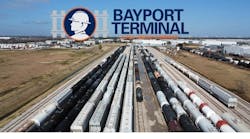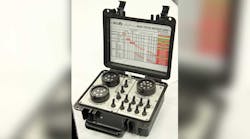WHEN problems (such as tank truck overfills) occur during operations at a petroleum terminal loading rack, it is sometimes difficult to determine the root cause of the issue. Is it the loading rack system or is it the tank transport being loaded?
John Sherman, Tidewater Terminal Co, and Brian Miller, Marathon Petroleum Co, teamed up to review the issue of tank truck overfills during the International Liquid Terminals Association’s 2016 International Operating Conference. As part of the presentation, Sherman discussed a case study detailing how one terminal operator was able to achieve a significant decrease in tank trailer overfill incident rates through better training and implementation of an effective rack management program.
Here is Sherman’s case study:
Refined products terminals have a very high exposure to spills on their truck loading racks. The petroleum terminal industry has a large and continually changing driver pool, little consistency in design across the racks, a wide range in the quality of driver training and experience, various levels of facility technician experience and with both facility and carriers constantly striving to control costs, these conditions can lead to failures. Fortunately, with a well-designed management system, these risks can be controlled and incidents virtually eliminated.
In early 2000 I assumed responsibility for a refined products load rack with an incident and significant near miss rate that demanded attention. We were averaging an incident or near miss—compartment overfills, spills, drive-offs with the truck still connected to the rack, trained drivers sharing loading cards with untrained drivers—on a weekly and sometimes daily basis. It quickly became apparent that our failures around the truck loading process were systemic and serious.
Working with our maintenance, operations, and health and safety staffs, we designed a process to review each step in the operation of our loading rack. Actual and potential failure points would be identified and then systematically addressed. We believed a load rack incident rate could be eliminated with strong company management, employee, carrier, and driver commitment, an effective driver and carrier management program, and a well-designed load rack maintenance program. The foundation of our program was the establishment and sharing of expectations with all facility employees, contractors and carriers and then following up on every commitment we made. In 18 months we reduced our incident rate from weekly to an average of two minor incidents annually with no loading rack spills. Additionally, terminal equipment reliability went from “something was always broken” to a 99.999% up rate.
This study discusses the failures we found and describes the program we designed in an effort to turn the load rack performance around and provide a safe and professional working environment. We didn’t throw money at the failures but rather we used root cause analysis on each incident and then applied common sense and best business practices. Our solutions involved establishing expectations and standards, revising some procedures and assuring everyone was properly trained. Combined, the elements of our program provided a load rack and driver group that arguably was one of the safest in the region.
The first step in our process involved understanding and defining the problems and then establishing our goals. At the simplest level, we found the terminal was really having only a couple of problems: drivers were overfilling truck compartments resulting in spills and we had numerous instances of drivers driving off the rack with the truck still connected. Unfortunately the solution wasn’t as simple as the problem.
We established two goals. The first was a zero incident rate. The second, with the exception of planned maintenance and supply disruptions out of our control, was that all products were to be available at all load spots 100% of the time. The goals are not unrelated. By maintaining a load rack in excellent mechanical condition and providing drivers the working conditions necessary to do their job correctly, we both demonstrated our commitment to them to maintain a safe, efficient work place and made it very clear that we were serious about improving all aspects of load rack performance. This very much included safety. We were not only holding drivers and carriers responsible for their actions, we were holding ourselves responsible for our performance. For terminal employees, we formalized the expectations through their performance goals and the review process. For drivers and carriers, we used the conditions of the terminal load rack agreements that allowed us to restrict carrier access based on performance.
The next step involved quantifying the problems. We collected several pages of data around each equipment failure, overfill, spill, near miss, cross contamination on the truck, and truck drive-offs while still connected to the rack. We captured information on as many variables as possible: sequence of events, driver and carrier name, size of the company, load position, design of the truck header and load rack, product loaded, meter number, customer account number, overfill probe manufacturer, part numbers and serial numbers, dates of last maintenance on any equipment involved in the spill (truck, load rack hardware and load rack software), truck compartment sizes, how many hours and days the driver or involved terminal personnel had been at work, how many years of experience they had, and what their level of knowledge was. And on and on. This involved substantial effort but without the data we wouldn’t be able to identify the root cause of the failures and spills. Rarely does an incident have one cause and the conditions we found on this rack were no different. Typically we had several substandard conditions contributing to the failure. We were experiencing the unintended consequences associated with numerous vendors, multiple contractors, ineffective maintenance and training, incomplete project management, and low expectations of everyone involved.
Identifying the root causes of the incidents fell to various cross functional teams that included department supervisors, maintenance technicians, key contractors and vendors, operations personnel including hourly employees, the safety department, and terminal management. As we collected the data we made the immediate repairs and looked for failure points and patterns. The data began to point to three significant issues: a load rack maintenance program that was subpar, a driver population that was prone to error, and truck and loading rack equipment that while designed to prevent overfills, did not consistently function as intended. We also reviewed the spills and load rack incidents that occurred during the preceding 24 months and examined the circumstances around those failures. Patterns began to emerge.
The data pointed to multiple problems. We had problems with everything:
• Load rack hardware
• Load rack software
• Terminal technician training
• Driver training
• Carrier equipment
• Consistent discipline
• And most importantly, the perception of terminal expectations.
When we analyzed the data we found that over 90% of the incidents included some form of driver error. The remaining 10% of the incidents were caused by terminal personnel or loading rack equipment failure. Of the overfill incidents involving driver error and resulting in a spill, each of the incidents also had a contributing substandard condition either on the truck or with the rack equipment.
We found that the driver errors resulting in a compartment overfill could be grouped into three categories:
• Entering an incorrect number of gallons on the meter preset (60%)
• Connecting a load arm to an incorrect compartment (14%)
• Failing to account for retain in a compartment (26%)
We also had two groupings of incidents that needed to be addressed that did not result in spills but were significant:
• Drivers driving off the load rack with the truck still connected (six incidents in 18 months)
• Drivers “guessing” as to how to load the truck or operate the rack (inadequate or no training)
We found that incidents caused solely by load rack equipment failure were usually due to a valve or meter component failure or software programming errors. The root causes of these particular failures were traced back to either the quality of our project management, the quality of our technicians training, or inadequacies in our preventive maintenance program.
When truck equipment was associated with a spill we found that the overfill probe was almost always involved. Either the probe failed to function as intended or it was not properly situated in the compartment such that it would provide the load rack a signal with sufficient time to stop product flow without overfilling the compartment. As we were looking at the rack performance, drivers began letting us know of problems they were having with our customer files in the load rack operating software. As a separate initiative, office personnel addressed that problem. Outdated customer files were purged and active customer files were updated, standardized and additional security levels and authorizations were created. For anyone responsible for maintaining customer files, the size of this task cannot be overstated.
Several interesting trends surfaced during our investigation and review of previous rack incidents:
The incident rate for jobbers and common carrier drivers was approximately five times higher than it was for company drivers. Company drivers averaged 1.3 incidents per 10,000 trucks loaded versus a jobber/common carrier rate of 6.7 incidents per 10,000 trucks loaded.
We found that the smaller the compartment the greater the likelihood of an incident. 48% of the incidents were in compartment sizes of 1,800 gallons or less. 39% of the incidents were in compartment sizes between 2,000 and 2,700 gallons. The remaining 13% of the incidents involved compartment sizes of 2,900 gallons or larger. The cause for the higher incident rate in the smaller compartments was due to the reduced outage and the intolerance a smaller compartment has for volumetric error. Entering an incorrect meter preset volume when filling a 4,500 gallon compartment generally won’t result in an incident but doing the same on a 900 gallon compartment will result in an incident. Drivers failing to get a full drain on a small compartment have less compartment outage to work with when refilling at the load rack and are more susceptible to an incident.
There were significant trends in the incident rate based on a drivers years of service. Drivers with less than 12 months of experience transporting fuel had a very high incident rate on our load rack. The rate dropped significantly in years two and three and then increased again in years four and five. Generally, once a driver reached seven years of fuel handling, he or she had developed a system for loading the truck that was effective, and the incident rate for drivers in this range was very low. However, it wasn’t zero. We did have a couple of incidents involving drivers with 10 to 15 years of fuel handling experience. One large carrier instituted a loading and unloading procedure that required their drivers to check each critical step three times (triple-check). This carrier brought their performance from the worst on the load rack to the best. Jobbers or carriers that formalized their loading procedures and required drivers to double check or triple check had a significantly lower incident rate than companies that had no such requirements.
As we began to understand where we were deficient in our process, we developed our action plan. As incidents occurred, the immediate cause was fixed and critical information was collected. Patterns began to emerge almost immediately and our search for the root causes moved along very quickly. After six weeks of collecting data and conducting the review of loading incidents from the previous two years, we had a good handle on our problems and what we needed to do. Our incident rate began dropping rapidly. At a high level, our plan involved:
• Assuring the PLC programming on each lane and riser was consistent, documented and password protected.
• Assuring equipment installed correctly, compatible, and protected from tampering.
• Assuring the load rack maintenance was being done correctly and at appropriate intervals.
• Assuring the drivers using the load rack were adequately trained.
• Assuring the design and layout of each lane was logical, user friendly, and ergonomically acceptable.
• Assuring the safety systems on the trucks (brake interlocks, overfill probes, etc) met minimum standards.
• Assuring the terminal disciplinary program was well communicated, understood, and consistently applied.
• Assuring all drivers, carriers, and contractors were aware of our expectations.
The action plan we adopted had multiple items.
Step one—We told the carriers and drivers that we were going to address the issues around the load rack and that our goal was zero incidents with a 100% up time (exclusive of planned maintenance and supply disruptions) on all load arms. We both mailed and faxed a letter signed by the terminal superintendent, operations and maintenance supervisors, and the terminal safety leaders to each carrier. The letters were also posted on each lane of the load rack for the drivers to read. The letter explained that companies probably would see some delays as we investigated failures. We also requested assistance in identifying any failures they saw that might not be obvious to the terminal.
Step two—We repaired all leaks on the rack equipment, pressure washed the rack and then painted it. We also implemented a weekly steam cleaning of the rack. The driver’s restroom was remodeled, painted, and placed on an aggressive cleaning cycle.
Step three—We addressed the load rack programming and maintenance program. We reviewed the PLC programming line by line and assured the programming on each lane and each riser was consistent, complete, documented, password protected, met our safety system requirements and that we had a minimum of two electronic and one hard copy back-up. We found several minor programming inconsistencies that required some housekeeping. We also found some significant programming errors in critical systems that required immediate correction. Our key vendors and company subject matter experts were asked to review our standards and procedures, provide critical commentary and if necessary, assist in training our technicians and operators. Based on their input, we established a standard that allowed a maximum of 20 gallons of product flow if an overfill sensor entered an alarm condition. Further, we fed the alarm into our terminal control room and allowed only an operator to reset the permissive allowing the driver to continue loading once the alarm condition was removed. This assured us that we were aware of a near miss and could investigate it accordingly. We implemented a comprehensive load rack inspection and testing program that was owned by operations and an aggressive preventive maintenance program that was owned by the maintenance group. The approach we took involved work on the front end preventing problems, not on the back end cleaning them up. Involving operators in the load rack inspections also developed a familiarity and comfort level with the equipment and fostered ownership of the asset.
Step four—We asked the carriers and drivers specifically what problems they were having on the load rack and then we fixed them. This included labeling and color coding of the load arms, risers and meters, adjusting the counter weights on the load arms to eliminate back strain, installing intrinsically safe telephones on each lane for immediate contact with a terminal operator if assistance was needed, placing signage well in advance of the load rack that listed any products that were unavailable or maintenance that was being done, removing tripping hazards, relocating vapor recovery hoses and bonding cables for ease of use and removing unnecessary or idled equipment from the lanes. We made the rack logical and user friendly rather than a minefield to be negotiated or a puzzle to be solved.
Step five—We established minimum truck equipment standards:
• Compartment size must be labeled at the loading header.
• We required brake interlocks on the loading headers and vapor hose connections.
• We required a minimum of 60 gallons of outage in each truck compartment regardless of size
• We required the carrier to test and certify in writing that their over fill probes were functional.
• We required accurate truck compartment strapping charts
Step six—We developed a “Petroleum Awareness” educational program for the drivers and required attendance by all drivers. Along with implementation of a consistent and well-communicated discipline program, this was the backbone of our incident prevention program. As we conducted our incident investigations, the lack of knowledge within the driver group concerning petroleum products was striking. It became apparent that many jobbers and carriers lacked the resources necessary to train their employees to the level we believed was necessary to eliminate the incidents we were having. To address this deficiency, each driver was required to attend a classroom session where we used a PowerPoint presentation to discuss how to properly handle gasoline and diesel, why these requirements were in place and what prevents individuals from doing their job properly. The typical class was 75 to 90 minutes long. At the end of the training class we gave the students a small pocket knife or hat and other handout in appreciation for attending. The handouts were stenciled with a safety message and our company logo. There was no exception granted to drivers who were previously certified to load on the rack no matter how many years of experience they had. To assist the carriers in meeting our requirement we held weekly classes at either 7 am or 3 pm to coincide with typical driver shifts. We also scheduled several classes around the region on various days and times and at the request of several carriers, conducted the training on their site as a part of their safety program. Drivers not meeting the requirement to attend the training session were locked off the rack.
Step seven—We implemented a discipline program and assured that each carrier and driver was aware of the components of the program. If an incident at the load rack was the result of terminal personnel or terminal equipment failure, we apologized to the driver and bought him lunch or dinner. If it was due to driver error, there was a minimum five-day suspension. We contacted the owners or senior managers of carriers that had a high incident rate, expressed our concerns and offered to help them improve their performance. Every carrier except one worked to eliminate their incidents. That one carrier was eventually suspended from the facility for 30 days and placed on probation for six months. While it made little sense to suspend a very important customer from the terminal, it made less sense to allow them to continue to load and place everyone’s health and safety in jeopardy. The suspension was a managed process and was done with the full support of our Marketing Department.
Step eight—We developed a driver handbook for the terminal and a copy was provided to each driver and carrier. The handbook contained whatever information a driver might need when visiting the terminal including load rack safety rules, evacuation routes, location of fire alarms, eye wash stations, fire extinguishers and terminal alarm descriptions, loading rack layout, paperwork guidelines, phone numbers for terminal operators or management, loading procedures, and the discipline policy.
Step nine—We implemented a carrier outreach program. We invited all carriers to a presentation by the division vice-president and answered questions on a broad range of subjects. We listened to any concerns or problems they had and created a list of go-to carriers that would provide honest, constructive feedback.
Step ten—The driver errors were addressed through the development of a comprehensive certification and discipline program for both the drivers and carriers. Drivers who had not loaded at the terminal in six months were required to demonstrate proficiency before their access was reestablished. Driver cards were eliminated and we migrated to a cardless system to prevent card sharing. We also established a minimum PPE policy including long pants, sleeved shirts, (FRC was not required at that time though it is now), solid footwear, head and eye protection, and appropriate hand protection.
We virtually eliminated the incident rate on the load rack. We dropped the rate from one per week to two minor incidents the following year, neither involving a spill. This was done by designing and implementing a comprehensive, multi-faceted program that assured our load rack was properly maintained, those using the load rack were trained and everyone in the facility understood why it was necessary to adhere to the rules and regulations of the facility. Our focus was on education and through education we were able to eliminate the need for discipline.
Once we understood why we had a high rate of incidents it became easy to manage. Our project management and preventive maintenance programs were lacking. We tightened up on them through improved management practices, the use of change management and assigning accountability. Working with the drivers and carriers presented a different challenge. The primary contributing factors in their high incident were lack of understanding of the hazards associated with handling fuels and complacency. Many jobbers and carriers lacked the resources or knowledge to train drivers to even a most basic level. Several companies sent drivers to load and they had never driven a tanker much less a fuel tanker. Many tank wagon drivers were loading until they reached the overfill probe and flow automatically stopped. Other drivers would intentionally enter more gallons on the preset than a compartment could hold. Then they would use the emergency stop button to shut off flow once the compartment was full. On occasion we found that these practices were due to the work direction provided by the jobber or carrier management. No wonder we had problems.
We established our expectations, shared them with our customers and then enforced them. We told them what we were going to do and then we did it. We also made them part of our solution by actively soliciting suggestions and acting on their input. Our approach was to educate the driver population and assure they understood why they needed to follow a procedure and what might influence their ability to stay focused on the job. It worked and the drivers appreciated it. It was a lot of work but it needed to be done. After 18 months of effort, we really didn’t have an incident rate. ♦









